- Home
- Jared Diamond
Upheaval: Turning Points for Nations in Crisis Page 10
Upheaval: Turning Points for Nations in Crisis Read online
Page 10
Finland’s history illustrates belief in a non-negotiable core value (factor #11): independence, and not being occupied by another power. Finns were prepared to fight for that core value, even though they thereby risked mass death. Fortunately for Finns, they survived and also retained their independence. There is no universal correct answer to that agonizing dilemma. Poles in 1939, Yugoslavs in 1941, and Hungarians in 1956 also refused, respectively, German, German, and Soviet demands and fought for their independence, but without Finland’s fortunate outcome: all three countries lost, became or remained occupied, and suffered cruelly under occupation. Conversely, Czechoslovakia in 1938, Estonia and Latvia and Lithuania in 1939, and Japan in August 1945 accepted, respectively, a German or Soviet or American ultimatum, because they judged their situation to be militarily hopeless. In retrospect, the situations of Czechoslovakia and Estonia may not have been hopeless: but we shall never know.
The factor that initially hindered and subsequently favored Finland’s crisis resolution was lack of national consensus about the crisis, and then the achievement of consensus (factor #1). Throughout the 1930’s Finland largely ignored the impending crisis with the Soviet Union, and then in 1939 miscalculated that Stalin’s demands were partly a bluff. From 1944 onwards there was instead a consensus, formulated as the Paasikivi-Kekkonen line, that the Finnish government had to talk frequently with Soviet political leaders and learn to see things from the Soviet point of view.
The three factors favorable to crisis solution that Finland conspicuously lacked, and for whose lack Finland had to compensate in other ways, were support from allies (factor #4), available models (factor #5), and freedom from geopolitical constraints (factor #12). Of the nations discussed in this book, none received less support from allies than did Finland: all of Finland’s traditional and potential friends refused to provide the substantive help for which Finland had been hoping during the Winter War. (Sweden did provide small non-governmental help in the form of about 8,000 volunteers and accepting refugee Finnish children, while Germany did provide essential military and economic help during the Continuation War.) Finland could not look to any model of a weak country that had succeeded in resisting Soviet or Nazi demands: almost all other European countries either acceded to such demands and lost their independence (like the Baltic Republics), or resisted and were brutally conquered (like Poland and Yugoslavia), or resisted successfully through their own military power, far exceeding Finland’s (only Britain), or preserved their independence through concessions far milder than those that the Soviet Union demanded of Finland (Switzerland’s and Sweden’s accommodations to Nazi Germany). Conversely, no other nation could use Finland’s successful tightrope act with the Soviet Union as a model (“Finlandization is not for export”). Finland’s freedom of choice was severely limited by the geopolitical constraint of its long border with its powerful Soviet neighbor; only post–World War Two Germany approached Finland in the degree to which more powerful countries limited its freedom to act.
Among our questions specific to national crises and not arising for personal crises, two warrant discussion for Finland: the role of leadership, and reconciliation after conflict. Finland did benefit from skilled military and political leadership during and after World War Two. As military leader, General Mannerheim was a master of allocating scarce resources, judging the relative dangers posed by Soviet threats on different war fronts, keeping cool and thinking clearly in excruciatingly painful situations, and retaining the confidence of his troops and officers. Finland’s prime minister and later president Juho Paasikivi and his successor Urho Kekkonen, besides both speaking fluent Russian, proved skillful in negotiating with Stalin from a position of weakness, winning and keeping Stalin’s trust despite his paranoia, and convincing Stalin that maintaining Finland’s independence would be good policy for the Soviet Union. (Imagine yourself in Paasikivi’s shoes in September 1944, when he flew to Moscow to meet Stalin for the peace negotiations to end the Continuation War, after he had already flown to Moscow for the peace negotiations of March 1940 to end the Winter War, and after Finland had broken that March 1940 agreement by siding with Germany and reconquering Karelia in the summer of 1941. What would you have said to Stalin in 1944?—“Believe me, you can trust me this time”?) But Mannerheim’s, Paasikivi’s, and Kekkonen’s impacts as leaders should not be exaggerated, because their aims and strategies were similar to those of other leading Finnish generals and politicians, although their skills were exceptional.
The other question specific to national crises concerns reconciliation after cruel internal conflict or civil war. Reconciliation in Finland after its civil war of 1918 was much speedier and more complete than reconciliation in Chile after the Pinochet military dictatorship (Chapter 4), while Indonesians have still done little to reach closure after the army-instigated genocide of 1965 (Chapter 5). A partial explanation involves national differences in the extent to which the army remained powerful and continued to threaten its former adversaries. The army stayed in power in Indonesia after 1965, and remained visible and threatening in Chile even after Pinochet had stepped down as president, whereas Finland’s army became less visible after the civil war. Another part of the explanation is Finns’ sense of the distinctiveness shared by all Finns: that both the winners and the losers of the Finnish Civil War shared the same egalitarian tradition, and were unique among the world’s people in speaking the Finnish language, reciting the Kalevala, and being the countrymen of Jean Sibelius and Paavo Nurmi.
Finland is thus the first of our two examples of countries experiencing a crisis due to a sudden external shock. In the next chapter, on Meiji-Era Japan, we shall discuss another country with strong national identity and a distinctive language, much more distinctive culturally than Finland, with even more drastic selective change, and with outstanding realism like Finland’s but with a different geopolitical situation that permitted Japan to pursue a long-term strategy more independent than Finland’s.
FIG. 3 Map of Japan
CHAPTER 3
THE ORIGINS OF MODERN JAPAN
My Japanese connections—Japan before 1853—Perry—1853 to 1868—The Meiji Era—Meiji reforms—“Westernization”—Overseas expansion—Crisis framework—Questions
Unlike the other countries discussed in this book, for Japan I don’t speak the language, haven’t lived there for prolonged periods, and visited it for the first time only two decades ago. However, I have had much opportunity to learn second-hand about Japan’s selective changes and its mixture of European with traditional Japanese features. When I moved to California from Boston on the U.S.’s East Coast, where I was born and grew up, I found myself in a part of the U.S. with a much larger Asian population, many of them Japanese or Japanese-Americans. Asians now form the largest proportion of the student body of my university (the University of California at Los Angeles), outnumbering students of European descent. I have many Japanese friends and colleagues, including a wonderful Japanese research assistant, who know the U.S. and Europe very well from having lived there for a long time, and who in some cases have intermarried. Conversely, I have many American friends and colleagues who know Japan very well from having lived there for a long time, and again in some cases from having intermarried. I myself acquired Japanese cousins and nieces when I married into a family with two Japanese branches.
As a result, I hear constantly about the differences between Japan and the U.S. or Europe, from Japanese, Americans, and Europeans with long experience of living both in Japan and in the U.S. and/or Europe. All of my Japanese relatives, students, friends, and colleagues talk about the big differences coexisting with the big similarities between Japanese and American/European societies. In alphabetical order without trying to rank them in importance, some of the differences that they identify involve: apologizing (or not apologizing), the difficulty of learning to read and write, enduring hardships silently, extensive socializing with prospective business clients, extreme politeness, feelings
towards foreigners, openly misogynous behavior, patient/doctor communication, pride in beautiful penmanship, reduced individualism, relations with parents-in-law, standing out as different from other people, the status of women, talking directly about feelings, unselfishness, ways of disagreeing with other people—and many other features.
All of those differences are legacies of traditional Japan, coexisting with Western influences on modern Japan. That mixing began with a crisis exploding on July 8, 1853, and accelerated with the Meiji Restoration of 1868 (of which more below), when Japan embarked on a program of selective change that extended over half-a-century. Meiji-Era Japan is perhaps the modern world’s outstanding example of selective national change, and of using other nations as models. Like Finland’s crisis, which we discussed in the previous chapter, Japan’s began abruptly with a foreign threat (but not with an actual attack). Like Finland, Japan exhibited outstanding honest self-appraisal, and patience at experimenting with different solutions until it found ones that worked. Unlike Finland, Japan adopted much more comprehensive selective changes and enjoyed greater freedom of action. Hence Japan in the Meiji Era offers a good case study to pair with our discussion of Finland.
Japan was the first modern non-European country to match European societies and overseas neo-European societies (the U.S., Canada, Australia, and New Zealand) in standard of living, industrialization, and technology. Japan today resembles Europe and neo-Europes not only economically and technologically but also in many political and social respects, such as in being a parliamentary democracy, having high literacy, adopting Western dress, and adopting Western music along with traditional Japanese music. But in other respects, especially social and cultural ones, Japan is still more different from all European societies than any European society is from other European societies. There is nothing surprising about those non-European aspects of Japanese society. They are entirely to be expected, because Japan lies 8,000 miles from Western Europe and has been heavily influenced by nearby countries of the Asian mainland (especially China and Korea), with which Japan shares a long history.
Before 1542, no European influence had reached Japan. There was then a period of influence associated with Europe’s overseas expansion (but limited by the great intervening distance) from 1542 to 1639, followed by a period of reduced influence until 1853. Most of the European aspects of contemporary Japanese society have arrived since 1853. Of course, they haven’t replaced everything about traditional Japan, of which much remains. That is, Japan, like Cocoanut Grove’s survivors after the fire, and like Britain after World War Two, is a mosaic of its old self and its new self—more so than any of the other six societies discussed in this book.
Until the Meiji Restoration, Japan’s actual ruler was a hereditary military dictator called the shogun, while the emperor was a figurehead without real power. Between 1639 and 1853, the shoguns limited Japanese contact with foreigners, thereby continuing a long Japanese history of lesser isolation arising from the effects of their island geography. That history may at first surprise us when we glance at a world map and compare Japan’s geography with that of the British Isles.
Superficially, these two archipelagoes appear to be geographic equivalents of each other off Eurasia’s east and west coasts, respectively. (Just look at a map to convince yourself.) Japan and Britain look roughly similar in area, and both lie near the Eurasian continent, so one would expect similar histories of involvement with the continent. In fact, since the time of Christ, Britain has been successfully invaded from the continent four times, Japan never. Conversely, Britain has had armies fighting on the continent in every century since the Norman Conquest of AD 1066, but until the late 19th century there were no Japanese armies on the continent except during two brief periods. Already during the Bronze Age over 3,000 years ago, there was vigorous trade between Britain and mainland Europe; British mines in Cornwall were the main source of tin for making European bronze. A century or two ago, Britain was the world’s leading trading nation, while Japanese overseas trade still remained small. Why do these huge differences apparently contradict straightforward geographic expectations?
The explanation for that contradiction involves important details of geography. While Japan and Britain look at a glance similar in area and isolation, Japan is actually five times farther from the continent (110 versus 22 miles), and 50% larger in area and much more fertile. Hence Japan’s population today is more than double Britain’s, and its production of land-grown food and timber and in-shore seafood is higher. Until modern industry required importation of oil and metals, Japan was largely self-sufficient in essential resources and had little need for foreign trade—unlike Britain. That’s the geographic background to the isolation that characterized most of Japanese history, and that merely increased after 1639.
Europeans first reached China and Japan by sea in AD 1514 and 1542, respectively. Japan, which had already been doing some trade with China and Korea, then began trading with four groups of Europeans: Portuguese, Spanish, Dutch, and British. That did not consist of direct trade between Japan and Europe, but instead of trade at settlements on the Chinese coast and elsewhere in Southeast Asia. Those European contacts affected spheres of Japanese society ranging from weapons to religion. When the first Portuguese adventurers reaching Japan in 1542 shot ducks with their primitive guns, Japanese observers were so impressed that they avidly developed their own firearms, with the result that by 1600 Japan had more and better guns than any other country in the world. The first Christian missionaries arrived in 1549, and by 1600 Japan had 300,000 Christians.
But the shoguns had reasons to be concerned about European influence in general, and about Christianity in particular. Europeans were accused of meddling in Japanese politics, and of supplying weapons to Japanese rebels against the Japanese government. Catholics preached intolerance of other religions, disobeyed Japanese government orders not to preach, and were perceived as loyal to a foreign ruler (the Pope). Hence after crucifying thousands of Japanese Christians, between 1636 and 1639 the shogun cut most ties between Japan and Europe. Christianity was banned. Most Japanese were forbidden to travel or live overseas. Japanese fishermen who drifted to sea, got picked up by European or American ships, and managed to return to Japan were often kept under house arrest or forbidden to talk about their experiences overseas. Visits by foreigners to Japan were banned except for Chinese traders confined to one area of the port city of Nagasaki, and Dutch traders confined to Deshima Island in Nagasaki harbor. (Because those Dutch were Protestants, they were considered non-Christian by Japan.) Once every four years, those Dutch traders were ordered to bring tribute to the Japanese capital, traveling by a prescribed route under watchful eyes, like dangerous microbes kept inside a sealed container. Some Japanese domains did succeed in continuing to trade with Korea, China, and the Ryukyu Islands, the archipelago several hundred miles south of Japan that includes Okinawa. Intermittent Korean trade visits to Japan were disguised to Japanese audiences as visits tolerated to receive Korean “tribute.” But all of those contacts remained limited in scale.
The small trade between the Netherlands and Japan was economically negligible. Instead, its significance to Japan was that those Dutch traders became an important source of information about Europe. Among the courses of instruction offered by Japanese private academies were so-called “Dutch studies.” Those classes taught information acquired from the Netherlands about practical and scientific subjects: especially Western medicine, astronomy, maps, surveying, guns, and explosives. Within the Japanese government’s Bureau of Astronomy was an office devoted to translating Dutch books on those subjects into Japanese. Much information about the outside world (including Europe) also came to Japan via China, Chinese books, and European books translated into Chinese.
In short, until 1853 Japan’s contact with foreigners was limited, and was controlled by the Japanese government.
Japan in 1853 was very unlike Japan today, and even unlike Japan in 190
0, in important ways. Somewhat like medieval Europe, Japan in 1853 was still a feudal hierarchical society divided into domains, each controlled by a lord called a daimyo, whose power exceeded that of a medieval European lord. At the apex of power stood the shogun (Plate 3.1), of the Tokugawa line of shoguns that had ruled Japan since 1603, and that controlled one-quarter of Japan’s rice-growing land. Daimyo required the shogun’s permission to marry, move, or erect or repair a castle. They were also required, in alternate years, to bring their retainers and take up residence at the shogun’s capital, at great expense to themselves. Besides the resulting tension between the shogun and the daimyo, other problems in Tokugawa Japan arose from the growing gap between the shogun’s expenses and his income, increasingly frequent rebellions, urbanization, and the rising merchant class. But the Tokugawa shoguns had coped with problems and had remained in power for 250 years, and were at no imminent risk of being overthrown. Instead, the shock that led to their overthrow was the arrival of the West.
The background to Western pressure on Japan was Western pressure on China, which produced far more goods desired by the West than did Japan. European consumers especially wanted Chinese tea and silk, but the West produced little that China wanted in return, so Europeans had to make up that trade deficit by shipping silver to China. In order to reduce the hemorrhaging of their silver stocks, British traders got the bright idea of shipping cheap opium from India to sell to China at prices below those of existing Chinese sources. (No, that British opium policy is not an invented anti-Western slander: it really was true, and needs to be remembered when one wants to understand modern Chinese attitudes towards the West.) The Chinese government understandably responded by denouncing opium as a health hazard, banning its importation, and demanding that European smugglers surrender all the opium stored on their ships anchored off China’s coast. Britain objected to that Chinese response as an illegal restraint of trade.

 Why Is Sex Fun?: The Evolution of Human Sexuality
Why Is Sex Fun?: The Evolution of Human Sexuality Guns, Germs, and Steel: The Fates of Human Societies
Guns, Germs, and Steel: The Fates of Human Societies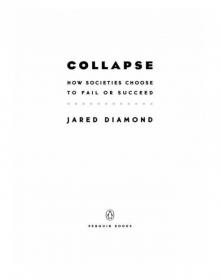 Collapse: How Societies Choose to Fail or Succeed
Collapse: How Societies Choose to Fail or Succeed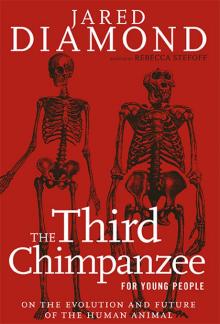 The Third Chimpanzee: The Evolution and Future of the Human Animal
The Third Chimpanzee: The Evolution and Future of the Human Animal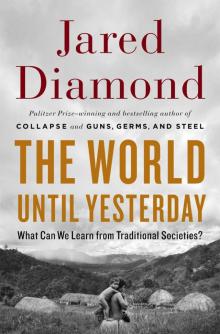 The World Until Yesterday: What Can We Learn From Traditional Societies?
The World Until Yesterday: What Can We Learn From Traditional Societies?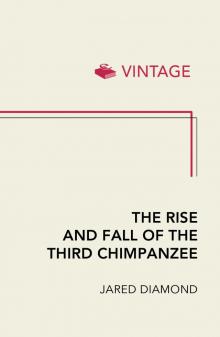 The Rise and Fall of the Third Chimpanzee
The Rise and Fall of the Third Chimpanzee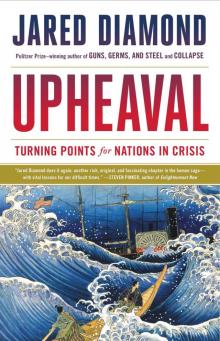 Upheaval: Turning Points for Nations in Crisis
Upheaval: Turning Points for Nations in Crisis Guns, Germs, and Steel
Guns, Germs, and Steel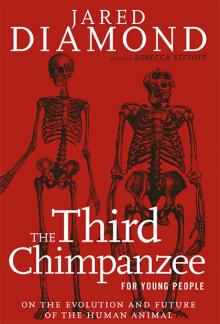 The Third Chimpanzee for Young People
The Third Chimpanzee for Young People Why Is Sex Fun?
Why Is Sex Fun?